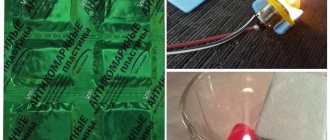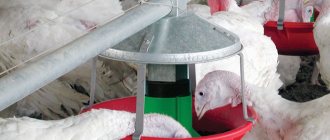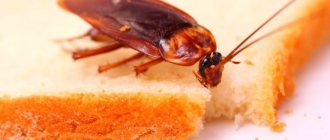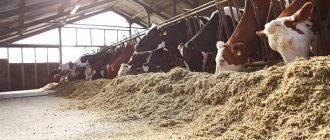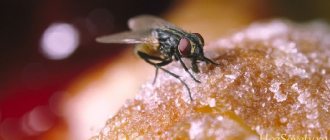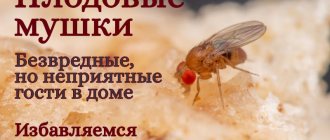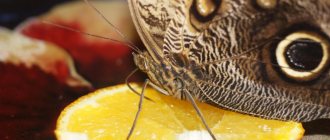Flies are one of nature's unpleasant creatures. They are “faithful companions” of human life, annoying with their buzzing and spreading a huge number of different microorganisms, including pathogens. Prolific dipteran pests live on average from 8 to 30 days. The female is capable of laying approximately 100 eggs in one ovipositor, and over a short life this number can reach 2000. Under favorable conditions, flies reproduce all year round. During this time, from 9 to 20 generations of indoor insects change. There are a large number of methods used to control annoying pests. Velcro for flies is an environmentally friendly and safe product for humans. It allows you to get rid of a large number of dipteran parasites without having a negative impact on the environment, the health of people and pets.
Adhesive tape - principle of operation
To feel comfortable in an apartment or country house during the warm season, you will need a large number of adhesive tapes.
Despite the fact that effective weapons against annoying insects have an affordable price, over the summer this can cost a significant amount. Therefore, folk craftsmen found a way out of a difficult situation. Using simple and accessible means, they were able to recreate an analogue of an industrially manufactured “trap”. Velcro against flies is a fairly simple design - a tape coated with a viscous and sticky component. The principle of its operation is based on attracting flies, due to the natural aromatic components included in the impregnation. Attracted by the specific smell, the insect sticks to the adhesive base and soon dies.
The presence of relatives on Velcro does not repel insects. The more flies on the tape, the more willingly the dipterans land on it.
Velcro for flies
Adhesive tapes are effective against all types of flies. Other types of winged insects, such as mosquitoes and midges, quite often use them as a resting place and also stick tightly to the trap. Considering that flies prefer to be located on ceilings and chandeliers, Velcro should be hung in the upper parts of the premises. The height of the placement should be such that the inhabitants of the apartment or house themselves do not fall into the “trap” intended for pests.
Velcro against flies, especially homemade ones, is an excellent solution to the problem of getting rid of unpleasant insects. We use them successfully in our dacha. The only drawback is that you have to change the tapes often, but everything is great. I recommend.
Victor, Nizhny Novgorod
Advantages and disadvantages
Despite their effectiveness and popularity, sticky traps have both disadvantages and advantages.
The disadvantages include:
- Ugly and even unaesthetic appearance.
- If there is a large concentration of flies, the trap is unable to cope with them and therefore becomes unusable.
- With low ceilings or improper hanging, there is a risk of a person coming into contact with the trap, which is not very pleasant.
Advantages:
- High efficiency.
- Affordable price.
- Environmentally friendly product.
- Can be used outdoors and indoors.
- Long service life.
- No smell.
- Compact and convenient, can be placed in any part of the room.
Homemade fly strips
If you don’t want to spend money on such a trifle, then you can make Velcro yourself.
From rosin
There are many recipes. Let's look at a few of the most popular ones.
Application of rosin:
- 30 g of rosin with 20 g of castor oil are placed in a tin can. The container is heated by immersing it in hot water. Iron conducts heat well, and the composition in the jar will heat up quickly. A few tablespoons of honey or jam are poured into the resulting mass and spread onto paper with a brush.
- Pine resin 300 g, 10 g wax, linseed oil 150 g, 50 g molasses or honey.
- 300 g rosin, 60 g jam or jam, 200 g linseed oil.
- 400 g rosin, 100 g pure bee honey, 200 ml castor oil, 40 ml glycerin oil.
First, purchase paper strips for depilation or use plain thick paper. Cosmetic strips are much better because of the synthetic fiber in the composition, which retains the sweet mass and does not absorb it.
Rosin is always heated in a water bath, just like resin. All ingredients are placed in tin cans, which can then be thrown away. When the resin begins to melt, stir it so that there are no undissolved pieces. Other ingredients are added to the melted rosin. The mass should turn into a homogeneous mixture, with a single color.
Prepare the paper, make a hole for the rope and a plastic jar at the other end. Wide sheets are cut in half.
The spreadable composition should be hot and viscous. When cooled down, immediately reheat and continue working. The layer is smeared with a thickness of 1-2 mm so that the mass does not flow down the edges and the fly does not escape from captivity.
From tree resin
You can buy it at a gardening store or collect it yourself. Vegetable or castor oil is added to the resin, and sugar is used instead of jam or honey. To enhance the stickiness of the composition, add wax or turpentine. If you take wax, then you need no more than 10 g of the substance per 200 g of resin.
Cut strips up to 8 cm wide and no more than 1.5 m long. Wax and resin are poured into the prepared container and heated in a water bath. Oils are added 2 times less than resins. And you need no more than 40 g of sugar or sugar syrup.
Loading …
From a tin can
The used tin can is wrapped with electrical tape or tape. Then the tape is peeled off, leaving a sticky mark on the can from the adhesive side of the tape. A light source is left inside the jar to attract more flies at night.
From a plastic bottle
Bottles are used to make useful items: from drinking bowls to slippers. Use scissors to cut out the top and unscrew the lid. Pour water inside the bottle. Add a little sugar and mix thoroughly. Fresh yeast and a spoonful of honey are also added to the water. The upper cut part is turned over and inserted into the remaining lower section.
There should be a distance between the bottle with syrup and the neck so that the fly can fly inside. Once an insect is trapped, it will not be able to get out.
Scotch
This is the easiest way. There is no need to come up with additional ingredients, cook, or spread. Pieces of tape are hung around the house. Their length should be such that all household members can easily move without touching the adhesive tape.
From adhesive plaster
The method is based on the adhesive substance of the patch and additional sugar-containing products. The tape itself does not have a distinct odor. And to attract flies, it is treated with sugar syrup or jam, and a layer of thermal paste is spread on top.
Thermal paste is used in computer equipment and is sold in the same departments. It turns out that flies come to the aroma of jam, land on the thermal paste and stick.
Plasters made for covering large post-operative wounds are suitable.
What you need to make a sticky trap
To make Velcro at home you will need:
- castor oil (if you don’t have it, you can use sunflower oil) – 100 g;
- rosin – 200 g;
- oilcloth, wrapping or landscape paper;
- honey or jam - 1 tbsp. l.
The presence of castor oil in the adhesive mixture, which is covered with Velcro for flies, allows it not to thicken for a long time. As a result, a film does not form on the surface of the sticky layer, which extends the life of the trap.
Homemade adhesive tape or Velcro for flies
This tape is effective against all types of flies, but it is especially effective against omnivorous and herbivorous species.
Other winged insects, including mosquitoes and midges, stick to the tape largely because they choose it as a resting place. Knowing the preferences of flying insects to sit on ceilings and chandeliers, it is better to hang adhesive tapes in the upper part of the rooms. To make adhesive tape you will need:
- Thick paper, cut into long strips 4-6 cm wide. You need to attach a loop to one end of the strip, from which it will be convenient to hang the trap.
- Rosin – 200 ml.
- Castor oil – 100 ml.
- Turpentine – 55 g.
- Granulated sugar – 4 tbsp. l.
- Water – 4 tbsp. l.
You need to boil syrup from water and sugar, bringing it to a yellowish-brown color. When the syrup has cooled a little, add rosin, turpentine and castor oil to it, mix everything thoroughly. Then soak strips of paper with this mixture and hang traps in places where flies are most concentrated - in the kitchen and veranda, above the entrance to the house and window openings, in the toilet.
The ribbons will attract flies with their smell, as well as the opportunity to sit on a surface that is comfortable from the point of view of insects. These devices remain sticky for a long time, so they need to be changed as they become filled with insects.
The given composition of sticky bait is very effective, but if the only thing you have in your house is sugar, you can get by with sugar syrup. The main thing is to make it so thick that flies stick to it well.
What is slime
This is a viscous mixture that can be used as an anti-stress toy or as a home and car cleaning product. Slimers clean the surface of dust, crumbs and feathers as they “stick” to the surface. It is enough to carefully shake off the dirt from the toy and you can continue to use it.
This mixture can keep craftsmen busy for hours, or even days. At the same time, when creating slime, you can control the viscosity, shade and even decorating components. There is no universal recipe - a unique combination of ingredients in each case gives the toy the desired consistency.
Interesting article: How to choose a construction set for a child: 3 tips
Bottle trap for flies and fruit flies
This is a closed type trap, but it will also attract insects with a sweet smell and catch them with a sticky substance. To make it, use a regular 1.5-2 liter plastic bottle of water or soda.
- The top third of the bottle needs to be cut off, and 200-300 ml of viscous sugar syrup should be poured into the bottom of the lower part. You can add a little honey, beer or fruit juice or fermented jam to the syrup. The consistency should be viscous enough so that insects quickly drown in it and are unable to escape.
- Insert the cut top part of the bottle into the bottom part with the neck down, without a cap. Fasten the two parts with a stapler or tape.
- In order for flies and flies to more actively fall into the bottle, its edges should be lightly greased with sweet syrup and placed where insects fly most often.
If you plan to place the trap outside, it is better to add a little white vinegar to it to repel honey bees and thereby protect them from death.
Instead of a plastic bottle, you can use a glass jar and funnel. The principle is the same: pour a little sweet viscous liquid into a jar, insert a funnel into the jar with the end down, and change the bait from time to time.
Instructions for use
Sticky tape as a way to control flies is very easy to use:
- the trap should be removed from the packaging;
- the tape has a special loop with which the Velcro can be placed in different corners of the room: on a chandelier or lamp, on various hooks, near a window or doorway; flies flying by will certainly become interested in the enticing smell of the trap and fall into it;
- It is not recommended to hang the adhesive tape too low, so as not to inadvertently touch the Velcro and stick to it;
- it is necessary to replace the trap as insects accumulate on it;
- It is prohibited to attach the tape near an open fire or in the presence of a draft; the trap must also be protected from scorching sunlight.
How to make your traps more effective
The likelihood of flies disappearing soon will increase if you use different types of traps. To catch more flies, it is better to make several traps and place them in different places in the apartment (or garden).
Important: flies should not have the opportunity to intercept a piece of food outside the trap. The effect will be much greater if the fly bait food is the only one available
Therefore, all food products must be put away in cupboards and the refrigerator, and fruit drops, if we are talking about a garden, must be taken outside the garden and buried.
The main advantages of using Velcro for flies are safety for the environment and humans, no side effects or odors, low cost, long service life, high efficiency.
Probably everyone knows such annoying insects as flies. Getting rid of them is quite simple, you just need to hang mesh on the windows (in extreme cases, tulle) and hang fly tape
It is important to prevent windows and doors from being opened for long periods of time.
There are several varieties of flies in nature. Most often we deal with a housefly. In rotten vegetables, garbage, and waste, a fly can lay up to 100 eggs at a time, from which larvae emerge after a few hours. Then the larvae pupate and transform into flies. This entire process will take about six days. The lifespan of a fly is 35-40 days. At the base of each leg, the fly has a sticky pad strewn with hairs, which allows it to move freely along smooth ceilings and walls. It is on these sticky pads that the fly carries many microorganisms. One fly can contain several million different microbes, including pathogenic ones. Flies are carriers of diseases such as tuberculosis, anthrax, dysentery, typhoid fever, and cholera.
The main condition for fighting flies is cleanliness. If there are no food remains in the room, then flies are rare guests here.
There are many different ones, but among them special attention should be paid to adhesive tape for flies (fly trap). Placing fly tape in residential, domestic and work areas allows you to effectively get rid of these annoying insects
The main advantages of using Velcro for flies are safety for the environment and humans, no side effects or odors, low cost, long service life, high efficiency. All this makes fly strips attractive to the consumer audience. It should be noted that you can buy sticky tape for flies for use not only indoors, but also outdoors - in the garden, on the balcony, summer kitchen, cottage, etc.
If you can’t buy fly sticky, then you can make it yourself. To do this, you need an iron can, in which you need to put 20 g of castor oil and 30 g of rosin. Place the jar in hot water and heat until the contents melt. Add a little jam or honey to the resulting melt and spread it on thick paper with a brush. There are other recipes for preparing an adhesive mixture for fly tape:
- 300 g rosin, 60 g honey, 200 g linseed oil;
- 400 g of rosin, 200 g of castor, vaseline or machine oil, 100 g of raw honey, 40 g of glycerin;
- 50 g of turpentine, 200 g of rosin, 50 g of sugar molasses or syrup, 100 g of castor oil;
- 150 g linseed oil, 300 g pine resin, 50 g honey or sugar syrup, 10 g wax.
The preparation of these mixtures follows the same principle: melt rosin or resin in a water bath, add other components and apply it to paper.
Buy sticky fly tapes RAPTOR
and other repellents for flies and harmful insects can be found in the Yusna Super Bio online store
There will certainly be help from traps placed in the apartment, if you do not forget about additional measures:
- all products must be removed;
- Before installing the trap, cleaning must be done;
- the source of the spread of midges or flies has been found and destroyed (any rotting piece of fruit lying behind furniture or in a corner, etc.);
- cabinets and drawers are washed with soap;
- bathrooms are treated with special products, pipes are cleaned of excess moisture, dirt and mucus;
- the plants are transplanted into new soil, watering is moderate (moisture in flower pots also often causes midges);
- feeders and cages of pets are cleaned, food does not stagnate in them.
If all of the above is done, it makes sense to make traps for annoying insects and install them in the right places.
How to make an electric shock flytrap
Attracting insects with light, electrocutes them
Do-it-yourself stun gun for flies - video
The method is effective, but not safe. Such a device should be turned on away from children and pets. Another disadvantage: the stun gun works as long as the battery is charged. As soon as its power weakens, the device will have to be re-soldered.
The most popular and interesting ways to make insect traps: some of them really help. Others are nothing more than a myth born of rumors and discussions. Try several options and choose the one that suits you best. And don’t let annoying flies bother your loved ones.
Source
From midges
Homemade ones are an excellent way out when you can’t use chemicals because family members, small children or animals are prone to allergies. And the savings here will be significant: store-bought traps have different prices, but for preparing them at home, almost nothing special is needed, everything is always at hand.
Bait jars
Take any glass jar, place 2 tablespoons of apple cider vinegar in it (its smell is very attractive to midges), you can add some sweet drink or syrup. The jar is closed with a plastic lid or film, in which entrance holes for midges are pierced with an awl or toothpick. Insects that fly inside on the scent of the bait will not be able to get back out. As they accumulate in the trap, the jar is either thrown away, or the midges are released on the street, and the container is sterilized.
Plastic bottle
The principle of making traps from a plastic bottle is the same as when making a jar trap: flying insects should not get out.
To do this, at the level of the “shoulders” of the bottle, where its main thickness begins, the upper part is evenly cut off and inserted with the narrow neck down. The joints are taped, and there should already be food bait at the bottom. The ideal bait for midges is sweet liquids, wine or beer, and rotting fruits.
To make the process of making a trap easier for yourself, you can not bother cutting off its top part, but simply make a funnel out of paper and insert it into the narrow neck.
Wine container
Take a regular bowl or container and pour a little wine into the bottom. The smell of this midge drink is very rich, and midges will immediately smell it. In addition, wine is produced by fermentation, and fermented foods are one of the favorite delicacies of these little bores.
Add a little dishwashing liquid or just liquid soap into the wine. In such a slippery mixture, midges will not be able to stay on the surface, their wings will stick together, and the insects will begin to drown.
Plastic bag
Not the most common method, but if you perform certain actions quickly, it can work well.
Place a sweet food bait (for example, fruit that is starting to spoil) inside the bag. Wait until midges accumulate there and very quickly tie the bag into a knot. After that, take it to the trash.
The main disadvantage of this method: the midges are also quite nimble, and some of them may have time to fly out if the actions when tying the bag are not very fast. And it is not always possible or desirable to wait until insects accumulate there.
Types of slimes
There are hundreds of varieties of slime. The following subspecies are more common:
| View | Peculiarity |
| Original | A very thick non-Newtonian fluid. The consistency is semi-liquid, viscous and moist. It spreads at rest and hardens when squeezed. |
| Jigli | Similar to mercury. Spreads into a round puddle when at rest, and hardens when compressed. |
| Fluffy | Airy slime - like foam |
| Batter | Looks like melted butter or paste - softest |
| Cloud | Same as fluffy, only smoother, without obvious “bubbles”, but crunches just as loudly |
| Transparent | It will work if you do not use PVA glue and other pigmented components |
| Aromaslime | Any slime with added aromatic oils |
Tools Overview
The most popular and effective today are the following:
- Adhesive tape from the manufacturer Insectum Laboratory. Pack of 4 pieces. cost 40 rubles. The packaging of the product will reliably protect your home from flies throughout the year. It contains a special adhesive and pheromones.
- Velcro Raptor. The tape will protect against pests for 2 months. For a room up to 15 square meters, 1 tape is enough. Cost 30 rubles. The product contains pheromones and rubber glue.
- Dipter tape. There are 104 pieces in a box. Price for 1 piece. equal to 5 rubles. It is based on special glue and pheromones.
- Flycatcher Ted. Designed to protect up to 15 sq.m. area. Price 5 rubles. Consists of paper impregnated with glue and pheromones.
- Clean house. One tape will protect 10 square meters. m. premises. The cost for one piece is 15 rubles.
- Moskitol. Designed for an area of 10 square meters. meters. Cost 15 rubles per piece. Contains rubber adhesive and pheromones.
- Fumitox. A meter-long tape with the active ingredient attractant. To protect a room of 15 square meters. meters you will need 1-2 tapes. Cost 20 rubles per piece. It consists of a meter-long strip of paper treated with glue and special hormones that attract insects.
Article information
Categories: Home and Garden
In other languages:
English: Make a Fly Trap, Español: hacer una trampa para moscas, Deutsch: Eine Fliegenfalle bauen, Português: Fazer Armadilha para Moscas, Italiano: Creare una Trappola per le Mosche, 中文: 自制捕蝇器, Bahasa Indonesia: Membuat Jebakan Lalat , Français: faire un piège à mouches, Nederlands: Een vliegenval maken, العربية: صناعة مصيدة للذباب, Tiếng Việt: Làm bẫy ruồi, ไท ย: ทำกับดักแมลงวัน, 日本語: ハエを捕まえる, Türkçe: Sinek Kapanı Nasıl Yapılır, 한국어 : 파리덫 만드는 방법, हिन्दी: मक्खियों से छुटकारा पाने के Fly Trap (Fly Trap)
- Seal
- Edit
This page has been viewed 70,345 times.
Was this article helpful?
Not really
Outdoor fly trap
This trap is effective against dung and blood-sucking flies, mosquitoes and other midges.
You can place it in the local area, next to the outdoor toilet, chicken coop, barn. How to do:
- Take a 1-5 liter metal can, for example a paint can. Using a knife or metal scissors, make a large hole in its side in the form of a window, and cover this window with a fine-mesh metal mesh. Secure the mesh with wire.
- Attach a low-power light bulb to the lid of the jar and bring the electrical wire outside. Use an extension cord if the outlet is far away.
- Prepare a poisonous solution to kill flies: add 3 g of agita or other insecticide for flies, a few drops of ammonia and lactic acid to 100 ml of water. Treat the entire body of the trap with this solution, and place a piece of meat inside.
Lactic acid imitates the body odor of humans and animals, thereby attracting flies. After some time, meat that has spoiled will also emit an odor attractive to flies. And the agita contains substances that attract flies - pheromones.
The light bulb will additionally attract insects at dusk. They will land on the body of the trap and receive a lethal dose of poison.
DIY fly tape
How to make a fly trap of this type? Many people think that this is impossible. But in fact, you can make a tape quickly. To do this, you need to take linseed or castor oil, resin or rosin. As bait you need to take glycerin, honey or sugar. Melt all ingredients in a water bath and apply them to paper tape. It will turn out to be an excellent analogue to a store device. Just such a tape is suitable for catching fruit flies, as they like to sit on the surface.
Now readers know how to make a trap for wasps and flies. Surely many are also interested in what goals the insect pursues. If bees live to make honey, then flies and wasps pursue completely different goals. They try to lay as many eggs as possible. One fly manages to reproduce up to 2000 larvae. Moreover, they live only a couple of months, and sometimes up to two weeks. During one clutch, the fly lays about 120 eggs.
A cesspool, a compost heap, or even soil in a flower pot are most suitable for this. The fly will appear in a couple of weeks. Moreover, the warmer the ambient temperature, the faster the larva matures. In winter, flies sleep. Active life begins only when the daily temperature totals +20 degrees. There is another interesting fact. Surely many are interested not only in how to make a trap at home, but also in why flies always sit on windows. They just have compound eyes, so they simply don’t notice transparent objects.
From flies
Flies are more dangerous in terms of spreading infections than midges. They fly into the house from everywhere: from garbage dumps, street toilets, from decaying organic matter on the street (and it could be the corpse of some small animal), etc. Therefore, it is simply necessary to fight them, and urgently.
Flies, like all insects, have an excellent sense of smell, and this is what will be emphasized when making traps. To do this, you can make traps from the same glass jar or bottle, as is done for midges. The same principle will work here: once inside, the insects will not fly free. But there are other methods.
Sticky can
You will need a regular empty can of stewed meat. The outside needs to be wrapped with tape or tape several times in a row, removing them after each wrapping. As a result, the walls of the jar should become sticky.
Place inside the jar either bait so that flies will flock to its smell, or a flashlight so that insects can fly towards the light at night. Having sat on such a sticky surface, they should stick to it. If the flies manage to escape and retreat, it means that the adhesiveness of the walls is insufficient. You'll have to wrap it a few more times.
When a lot of flies stick to the jar, throw the trap in a landfill, but only wear gloves.
Adhesive tapes
To make such a trap with your own hands, you will need to cut several paper strips 2.5 X 15 cm. In each of them, pierce a hole for a rope at one end (about 2.5 cm from the edge). Thread the rope through the holes and tie it into a knot. Soak the ribbons in water prepared in advance with sugar and a spoonful of honey (you can do without it) and let them dry, laying them out on parchment.
Once dry, hang the adhesive tapes on hooks and nails in the room. The effect will be greater if each Velcro hangs next to several others.
The only but very important condition: the syrup must be very sticky, otherwise the flies will not stick. With sufficient stickiness, such a homemade trap will help not only against flies, but also against mosquitoes and other midges
Any such methods for catching midges and flies are extremely simple and cheap, effective, and most importantly, safe for everyone around. This is what is required when there are pets and people in the house who are susceptible to inappropriate reactions to chemicals due to age or health problems.
A bag of water as a fly repeller
There is an opinion that flies do not like mirror surfaces that reflect sunlight. Therefore, as some housewives advise, you need to do the following:
The method, frankly speaking, is dubious. This way you can scare away sparrows and other small birds, but not insects. Regarding mirror surfaces, a reasonable question also arises: if flies do not tolerate them, why do we clean mirrors from traces of flies in the summer, almost every day?
This is how they try to repel flies in Asia.
I wonder if the method actually works? Here's what people who have tried this repeller say:
I tested this method and did not notice any effect. The flies flew and fly, sit on these bags and do not show any signs of wild horror at the sight of them.
jar-ohty [76.1K]
https://www.bolshoyvopros.ru/questions/1557794-pravda—chto-podveshennye-pakety-s-vodoj-i-monetkami-vnutri-otpugivajut-muh.html
Just imagine. A fly flies and flies into the apartment. An ordinary apartment, ordinary surroundings. Only there are bags hanging around (for no apparent reason!), and in them (who would have thought!) there is water, and in it (in general!) there are coins. The fly is thinking. Surely there are crazy people living in the apartment. It is necessary, the fly decides, to stay away from here. You can expect everything from psychos.
Mikhail Belodedov
https://www.bolshoyvopros.ru/questions/1557794-pravda—chto-podveshennye-pakety-s-vodoj-i-monetkami-vnutri-otpugivajut-muh.html
Mythbusters in season 10 (episode 157) refuted the myth that hanging a transparent bag of water repels flies. They conducted a test, and it turned out that the package, on the contrary, lures!
Ksusja
https://www.forumhouse.ru/threads/5889/page-6
TOP 5 best adhesive tapes against flies
Insects are attracted by the smell of glue, which for them is similar to a sweet treat, so they do not fly past the tape, but sit on it. The glue is quite tenacious, it’s not like a fly can’t tear itself away from it, it’s even difficult to tear off the tape when it accidentally sticks to an object. Therefore, such devices are hung only in free “flight”, vertically and away from furniture, chandeliers, curtains and passage places where people could touch it with their heads. Each tape has a special button for these purposes, which is attached to a horizontal surface so that the tape hangs vertically.
In addition to everything else that is offered on the shelves of shops and supermarkets, the insecticide market offers one of the options for combating flies in the house - adhesive tapes
But they are NOT all equally good, which is why it is so important to follow the ratings of the products in order to buy the best for your home. The mechanism of operation of the tapes is very simple
All you have to do is carefully unroll the tape, find a place where you can attach it and wait out its duration while flies stick to it day after day. Then the entire tape, along with the flies, is thrown into the trash. Let's look at the TOP 5 best adhesive tapes for fighting flies.
5th place – Flop!
- Product release - China
- The release form is a sleeve with twisted adhesive tape inside and a small fastener in the form of a metal button.
- Instructions on how to use the tape can be found directly on the sleeve packaging.
- Caution - place it indoors away from your face, hair, curtains, wallpaper, chandeliers and other objects because the tape is firmly glued.
- Toxicity for humans and pets is low (4th class of chemical hazard).
- The effect lasts approximately 30 days.
- The shelf life in packaged form is up to 3 years, then the glue dries out, hardens and becomes useless.
- The approximate cost of 1 sleeve is from 10-15 rubles.
4th place – Clean house
- Country of origin: Russia.
- The form of the product is adhesive tape in a protective cardboard package with fastening – a metal button.
- Instructions for use are located directly on the packaging.
- Features of use - cannot be placed near objects, fabrics and at a height so that it reaches the heads of people passing under the tape.
- Toxicity for humans is medium (hazard class 3).
- Effect - the tape is designed for 30-35 days.
- Shelf life – 3 years.
- Approximate price – 15 rubles.
3rd place – Fumitox
- Tape production – Russia
- Product form – a set of adhesive anti-fly tapes of 4 pieces in a protective cardboard package, each with fasteners – metal buttons.
- An active attractant is an attractant.
- How to use - slowly pull the red loop, the “serpentine” of adhesive tape will open, with a button at the end. Using fasteners, the tape is placed on a horizontal surface so that it hangs vertically away from various objects (so as not to stick).
- Cautions - do not hang such ribbons near heating devices, open fire or in the sun.
- Toxicity for humans and animals is average, nothing harmful evaporates.
- Consumption – for a room area of 10 sq. m. use 2-3 tapes.
- The effect lasts 1-1.5 months.
- Shelf life in unopened packaging is 4 years.
- The average price per package (4 pcs.) is 70 rubles.
2nd place – Lethal force
- Country of origin: Russia.
- The form of the product is adhesive tapes, 4 pieces in one package, with a protective cardboard sleeve on each of them and a special fastener-button.
- Instructions for use: slowly pull the loop and use the button to attach the unfolded tape to the ceiling or other place using the loop so that it hangs down.
- Tips - it is best to hang the ribbons where flies fly most, and also so as not to touch your head, away from various objects.
- What to do if the tape stains your hands or objects - you can remove traces of glue on any surface using an oiled swab.
- Toxicity – low, safe for people and animals.
- The effect of the tape is up to 6 months!
- Shelf life when unopened is 3 years.
- The approximate cost for a package of 4 pieces is 47-52 rubles.
1st place – Boyscout “Help”
- Country of origin: Russia.
- Form – 4 tapes in a cardboard package with fasteners, loops and a box.
- Instructions on how to use are written on the packaging of each sleeve.
- Do not hang it too low, in walk-through areas, or near objects or fabrics.
- Toxicity – safe for people and animals.
- Consumption – per 10 sq. m room, it is enough to hang 2 or 3 ribbons.
- Shelf life – 3 years.
- Approximate price – 44 rubles. per package.
DIY fly tape
Despite the fact that the cost of adhesive tapes is low, you can make it yourself.
In order to make this cheap remedy yourself, you need:
- Buy thick paper (both those used in everyday life for baking and those used for waxing are suitable).
- Prepare a bait mixture, the volume of which depends on the size of the paper. The larger the future tape, the greater the mixture consumption:
- Mix 25 milliliters of linseed oil with 30 grams of rosin and 10 grams of honey.
- Mix 5 grams of wax with a small amount of honey and pine resin.
- Mix 100 grams of rosin with 50 grams of castor oil and 25 milliliters of sugar syrup.
- Add 50 grams of honey to 200 grams of rosin, 100 grams of castor oil and 20 ml. glycerin.
- 100 grams of rosin, 50 grams of turpentine, 50 grams of sugar stream and 50 grams of castor oil. Mix all.
- Glue a loop of thread to the paper so that it can be hung.
- With the resulting mixture, brought to a hot state in a water bath, spread the cut paper with loops with a brush to a layer of up to 3 mm. It is not recommended to apply the mixture too much, as it will then start to run off.
- The tapes are ready for use. They can be placed in any part of the room.
There is another way to prepare a homemade remedy for these harmful insects, but this is already considered a poisonous remedy. For this you will need:
- thick paper;
- solution:
- 10 grams of ground black pepper, mix with 10 grams of sugar and add 70 grams of milk;
- a teaspoon of formaldehyde is mixed with 3 tablespoons of sweet water and milk;
- hexochlorane in a ratio of 1:1;
Heat the prepared solution a little and saturate the paper with it.
Transfer the paper to a plate or tray and place it in an area where flies gather.
General rules of application:
- The adhesive tape must be removed from the packaging and hung on the ceiling (chandelier or lamp), to a door or window opening, etc. using a loop.
- Flies will fly by and stick their paws to the Velcro.
- Once the tape has accumulated a large number of insects and there is no room left on it, it must be disposed of with other household waste and a new one placed in its place.
- It is not recommended to place the trap in direct exposure to sunlight, open fire or drafts.
The operating principle is simple: flies fly and land on suspended paper treated with a fly-attracting agent, sticking to it forever. The more flies already sitting on the tape, the more of their relatives want to get there too. Manufacturers often put drawn pictures of insects on paper to further increase the desire of flies to sit on the trap.
How Velcro works
This is the simplest remedy - a trap for harmful insects. The classic type of Velcro is a sheet of paper rolled into a tube and soaked in a luring substance. Insects, feeling the aroma, fly to the tape and stick with their paws.
The popular bookmaker has released a mobile application for Android, you can follow the link absolutely free.
Ribbons vary in color and length. They are attached either to the ceiling or to furniture or chandeliers. To ensure that the structure does not dangle from drafts, it is secured by hanging a plastic coil from below.
What the device is treated with can be organic (honey, sugar syrup) or chemical (rosin, etc.). The tape hangs until there is no free space left for flies or until the composition dries.
It is not recommended to hang the tape at human height; you will constantly hit your head.
DIY traps
Today, there are a sufficient number of different products on sale that are designed to combat flies and mosquitoes. But not everyone has the financial and physical capabilities to acquire and use them. In this case, do-it-yourself fly traps from scrap materials are suitable.
Insects cannot escape from traps covered with cones
Fly Trap
Flies are quite harmful and annoying insects. They are not only annoying, but also carriers of various types of infections. There are several ways to deal with them. One of them is to make a fly trap with your own hands. Below are the trap options:
- Velcro for flies. They can be purchased at the store, but if you don’t have money, you can make them yourself. To do this you need a sheet of paper, rosin, castor oil and honey. Melt rosin with castor oil in a water bath and add honey for flavor. Then a sheet of paper is dipped into this mixture and hung in places where flies congregate. Flies follow the smell and stick.
- Liquid bait for flies. You will need a jar, a square sheet of cardboard and sweet syrup or honey. Pour syrup or honey into the bottom of the jar; it will serve as bait. We roll up a funnel from a sheet of paper and lower it with the spout down into the jar. The hole on the funnel should be small so that flies cannot crawl back out. The flies crawl into the bait jar through the funnel and die there.
A DIY fly trap is an effective method of controlling flies. But there is a flower - a predator that eats flies. It is called Dionea or Venus flytrap. It is named after the Greek goddess Dionea. The flower is quite unpretentious, so caring for it at home is not difficult. The soil for the flower should consist of sand and sphagnum moss in a ratio of 1/3. Dionea can only be watered with rain or filtered water, pouring it into a tray. The flower itself regulates the water supply. He loves sunlight, but not direct rays. Feeding the flower should be done once a week.
A Venus flytrap can eat a couple of insects a week.
Trap for killing mosquitoes.
With the onset of warm days, the problem arises of how to get rid of mosquitoes. There are quite a few different mosquito repellent sprays and ointments. But if you don’t want to spend your hard-earned money, then you can make a mosquito trap with your own hands. A homemade trap is also quite effective in destroying them. Many people know that mosquitoes bite in order to lay larvae. How do they find the victim? Mosquitoes react to carbon dioxide, which humans release when breathing. We will use this in making a mosquito trap. Below are the steps for making a trap from a plastic bottle with your own hands:
- Take a two-liter plastic bottle and cut off a third of the bottle from the neck. It turns out to be a cone.
- Preparing mosquito bait. In half a glass of warm water, dilute 5 grams of yeast and half a glass of sugar. Pour this entire mixture into the cut off part of the bottle.
- Close the bottle from the top with the cone down and secure with tape.
- Be sure to wrap the bottle in foil or dark paper, since mosquitoes do not like light.
The principle of operation of this mosquito trap is that the yeast begins to ferment and produce carbon dioxide, which serves as an excellent bait for mosquitoes. They fly into the bottle and die there.
Popular methods of controlling flies in an apartment and house
Fly traps are very popular and effective in controlling insects. They can be made from available materials. The most common types of traps among the population are:
- You need to place bait in a glass jar, which can be honey, syrup, or sugar-sweetened water. A paper cone is inserted into the jar so that the wide part is located on top, and the narrow part is located from the bottom of the jar, but not close to it. Insects attracted by the bait will fly into the jar through the hole in the cone, but will not be able to get out.
- The most basic trap is an open bottle of beer with some drink left in it. The flies will flock to the smell, penetrate the bottle and will not be able to fly out.
- The following trap is also effective: pour a little vinegar with a few drops of dishwashing liquid into a glass jar. Wrap the top of the jar with cling film and make a hole in it to fit an adult fly. A fly that has flown into a jar will not be able to escape and will drown in the prepared mixture.
To combat hated insects, you can use a special device for killing flies. Manufacturers offer various models that make life easier.
Insecticidal lamps come in different shapes and sizes: as sconces, floor-standing or tabletop units. They operate on electricity, are absolutely harmless to people and can be used indoors around the clock. How is flies controlled? The devices emit ultraviolet rays of a certain spectrum that attract flies. Insects that fly close to them die from electric shock. Many models are equipped with adhesive sheets or a special design that prevent dead insects from falling onto the floor or table, ensuring high hygiene.
- There are devices that attract flies using UV radiation, and then suck in the flying insects. Silent operation, hygiene and safety make it possible to use the devices in the house and apartment.
- Insect killer is an effective and unique device against flies. They are very easy to install and their operating radius ranges from 4000 m2. It cannot be installed indoors, so this is one of the popular models for private homes. By installing it in the yard, you can enjoy your holiday without being distracted by annoying insects. The likelihood of flies entering the house through windows and doors is also greatly reduced. How does this device work? It produces carbon dioxide, moisture and heat, which attract flies. Insects that fly up are sucked into the net and die there within 24 hours from dehydration.
- Sticky tape or tape destroyers are an effective trap. It consists of tape and a sticky sheet. It is enough to hang it in the room where there are the most flies. They will attract insects with a specific smell. A fly that lands on them will no longer be able to come unstuck and will die.

